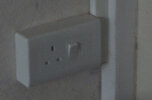Yes you should have continuity for all three line, neutral and earth if a ring final. Any spur from a ring final will have a 13 amp fuse or two to protect it, this could be in the plug if it supplies a single or double socket or in a FCU if it supplies multiple sockets. With a 32 amp supply from a B type MCB/RCBO the current must be able to exceed 5 x 32 amp to trip the overload, plus 5% safety margin, so line - neutral loop impedance using ohms law is 230/160 = 1.44 Ω and with the 5% safety margin 1.38 Ω however once it goes through a 13 amp fuse that is increased to 2.42 Ω not sure if 5% required for a fuse, the problem is a MCB is two devices in one, the thermal trip is 32 amp, the magnetic trip is 5 times that value, and if it is just under the 160 amp required the tripping time jumps from around 0.01 seconds to around 5 seconds, not looked at the chart but it takes far longer to trip.
Were with a fuse it may go from 0.1 seconds to 0.15 no where near the jump found with a trip.
So the loop impedance with a 32 amp MCB/RCBO is very important just one meter too long can cause problems, but with a fuse the difference is very much less, so if 2.50 Ω instead of 2.42 Ω the tripping time has not altered much, but with an MCB 0.38 Ω likely short circuit will disconnect in 0.01 seconds but at 1.50 jumps to 5 seconds.
The problem is the cheap plug in testers were designed for Europe with 16 or 20 amp supplies, so pass anything over 1.9 Ω, that is OK for a 20 amp radial but not a 32 amp ring final.
We can do a dead test R1 + R2 as it is called, but that needs a low ohmmeter which uses at least 200 mA, so not the standard multi meter.
In the real world the loop impedance to trip the B32 is far higher than the loop impedance that equates to a 5% volt drop, 0.95 Ω if incomer is 0.35 Ω so one should be no where near the limit, it works out at 106 meters of 2.5 mm² the old one was 4% so 88 meters. Going over the volt drop limit is not really dangerous, so would not worry about it.
However for an electrician best option is to extend the ring, but for DIY where they have not got the test equipment a fused spur is the safer option, I used a socket and fuse plus switch

using the
Screwfix LAP range, my dad trusted to the lord, but 7/029 is larger than 2.5 mm² so he could get away with it.
If you have the EICR from when you moved in, it will show how close to the wind you are sailing, today with RCD protection we are only really worried about line - neutral loop impedance. The earth loop impedance is likely well within limits to trip a RCD.
In real life we are not likely to be anywhere near the limits, I can borrow my sons loop impedance meter, it was mine, but I would be happy running for 6 months before testing as I know the old readings so also have a good idea on how much I can add.


